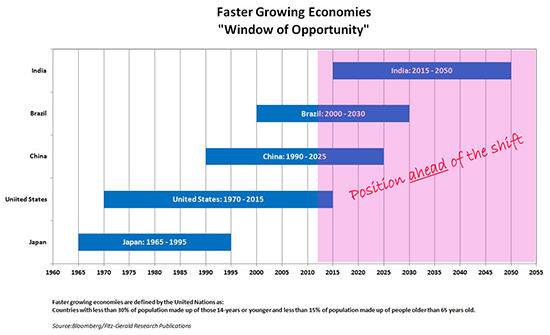China's grave dancers have taken great pleasure in convincing millions of investors that the nation will never succeed based on any number of erroneous arguments...
...not democratic
...not capitalist
...not worthy of world leadership
Underneath it all, this was little more than thinly veiled contempt for Beijing's 35-year-old "one child" policy. Called yousheng, the law has averted an estimated 400 million births over the years in the name of modernization and efficient resource consumption.
Now that law's been scrapped, and couples will be allowed to have two children.
The White House and much of the mainstream media wasted no time posturing after the announcement. Press Secretary Josh Earnest, for example, noted that the policy is a "positive step," but that "we also look forward to the day when birth limits are abandoned altogether." Amnesty International said bluntly that the policy change was "not enough."
They're missing the point.
China's policy reversal is the gutsiest move yet in the ongoing global financial crisis. It's a game changer of the highest magnitude. Moreover, it's great news for savvy investors.
Today we're going to talk about why and, of course, how to align your money for maximum profits.
China Re-Opened the World's Most Important Window
We've talked a lot about China over the years together and, at this point, you should be well-versed in the logic propelling that nation onto the world's stage. But what we haven't spent a lot of time talking about is what's driving things behind the scenes.
Today, we're going to change that with a look at something called the "Window of Opportunity."
The Window of Opportunity is a little-understood data point that actually drives several of our Unstoppable Trends, including Demographics, Medicine, and Human Augmentation.
If you've never heard the term before, the "window" refers to the composition of a country's working age population. While there are some variations, generally that's people between the ages of 15 and 65. (Remember these numbers, by the way, because we're going to come back to them in a few minutes.)
Anyway, the window is "opening" when a country's population is growing and the number of younger people is declining at a time when the older population is small or in decline. It's "closing" when the working age population is in decline at a time when the number of children is growing together with the number of elderly who are no longer working.
The reason why is pretty straight forward.
People live longer. Children and the elderly produce less, yet consume more. The cost of urbanization rises, as does systemic government spending even as per capita output falls to cope with rising dependency on everything from social services to private resources.
Typically, the window is around 30 to 40 years long and rotates around the world. For example, Japan's window was opening from 1965 to 1995. Our window was open here in the United States from 1970 to 2015. China's opened up in 1990 and will continue to open until 2025. Brazil and India will follow.
I realize that this can be hard to comprehend, so let me put this another way.
In 1975, there were three people living in emerging market countries for every one in a developed country. By 2009, that had changed to 4.7 people in emerging market countries for every one in a developed country. By 2050, the figure will be 7.5 to 1. That's a huge shift only 36 years from now.
Which means, by implication, now's the time to act if you really want to make your fortune.
If this doesn't make sense, consider our own history...
The world's truly pivotal fortunes were made roughly 25 years before the mainstream populace grasped the shift I am sharing with you today. Mellon, Vanderbilt, Carnegie, Warburg, Pincus, Rothschild, Buffett, Templeton... they all put their money ahead of massive shifts in working age populations around the world.
That's why China's move is so far-sighted. They're doing the same thing.
Beijing knew darn well the window we're talking about was closing and that the one child policy put in place in 1980 to control modernization and resource consumption would have to change, "or else."
Barring this week's policy revision, China was on track to surpass Japan and become home to the world's most elderly population in less than 15 years, with an estimated 400 million people more than 60 years old.
Remember those figures I mentioned earlier?
It's no coincidence that the demographic window is defined by a working age population between 15 and 65 years of age. China knows that every single child born over the next 15 years prevents the window from closing. If projections hold, we're talking about another 75 million to 100 million people entering the Chinese workforce by 2030.
And that's your entry.
A bigger workforce not only drives productivity but consumption, too.
China's middle class is already the world's largest. By 2020, more than one billion middle class folks there will have consumed more than $41 trillion in goods and services, according to The Boston Consulting Group. By 2030, that figure may stand at $60 trillion. To put that in perspective, U.S. GDP is approximately $17.94 trillion as of mid-2015.
China's economy is 25 times bigger now than it was in 1990. By 2035, it could double again, especially when you factor in another 75 million to 100 million people who would have otherwise literally been prevented from being born.
That's going to drive companies like NIKE Inc. (NYSE: NKE), Starbucks Corp. (Nasdaq: SBUX), and Apple Inc. (Nasdaq: AAPL) to levels most investors cannot imagine today. As I noted in this article, that's going to give those companies a powerful boost and investors plenty of profits.
It's also going to create a whole host of new Chinese companies at the same time.
For example, companies like Meizu and Xiaomi are mobile handset makers second only to Apple in Asia, even though they're virtually unknown here. Athletic sporting gear company Li Ning is giving NIKE a run for its money even though it sells 99% of its products within China.
Ping An, Yunnan Baiyao, Shuanghui... these are names completely unknown to western investors... at the moment.
If that gives you pause given China's well documented and very recent history of stock fraud, manipulated earnings, and questionable accounting, I understand. But I encourage you to get past that and consider investing in one or both of the following exchange-traded funds so you can get ahead of the "window":
- Deutsche X-trackers Harvest CSI 500 China A-Shares Small Cap (NYSE Arca: ASHS)
- Guggenheim China Small Cap Index ETF (NYSE Arca: HAO)
The former is a broad-based market type index holding the 500 smallest and most liquid Chinese A-Shares, while the latter is much the same, but introduces a threshold of $1.5 billion, above which investments are excluded. I have no doubt tomorrow's winners are among them.
The game here is not instant gains, so don't pile in thinking you're going to be living large any time soon. China's going to be volatile for some time to come, and its financial markets will reflect that exactly as any growing nation's financial markets do. Exactly as ours did.
Over time, though, things will begin to settle down as part of the maturation process as China's legal, financial, and economic systems catch up. And that's when capital growth really sets in.
Ordinarily, I'd encourage you to run a trailing stop to protect your capital, but in this case I think position sizing to 2% or less is the way to go. That way you can buy shares, tuck them away, and come back in a few years' time without worrying about daily volatility.
Keith has discovered a small-cap company that's poised to deliver 720% gains as it saves California from their present state of crisis. Click here to get full access to Keith's exclusive briefing and all of his Total Wealth Research at no charge.
Don't miss a profit opportunity. Follow us on Facebook and Twitter.
About the Author
Keith is a seasoned market analyst and professional trader with more than 37 years of global experience. He is one of very few experts to correctly see both the dot.bomb crisis and the ongoing financial crisis coming ahead of time - and one of even fewer to help millions of investors around the world successfully navigate them both. Forbes hailed him as a "Market Visionary." He is a regular on FOX Business News and Yahoo! Finance, and his observations have been featured in Bloomberg, The Wall Street Journal, WIRED, and MarketWatch. Keith previously led The Money Map Report, Money Map's flagship newsletter, as Chief Investment Strategist, from 20007 to 2020. Keith holds a BS in management and finance from Skidmore College and an MS in international finance (with a focus on Japanese business science) from Chaminade University. He regularly travels the world in search of investment opportunities others don't yet see or understand.




